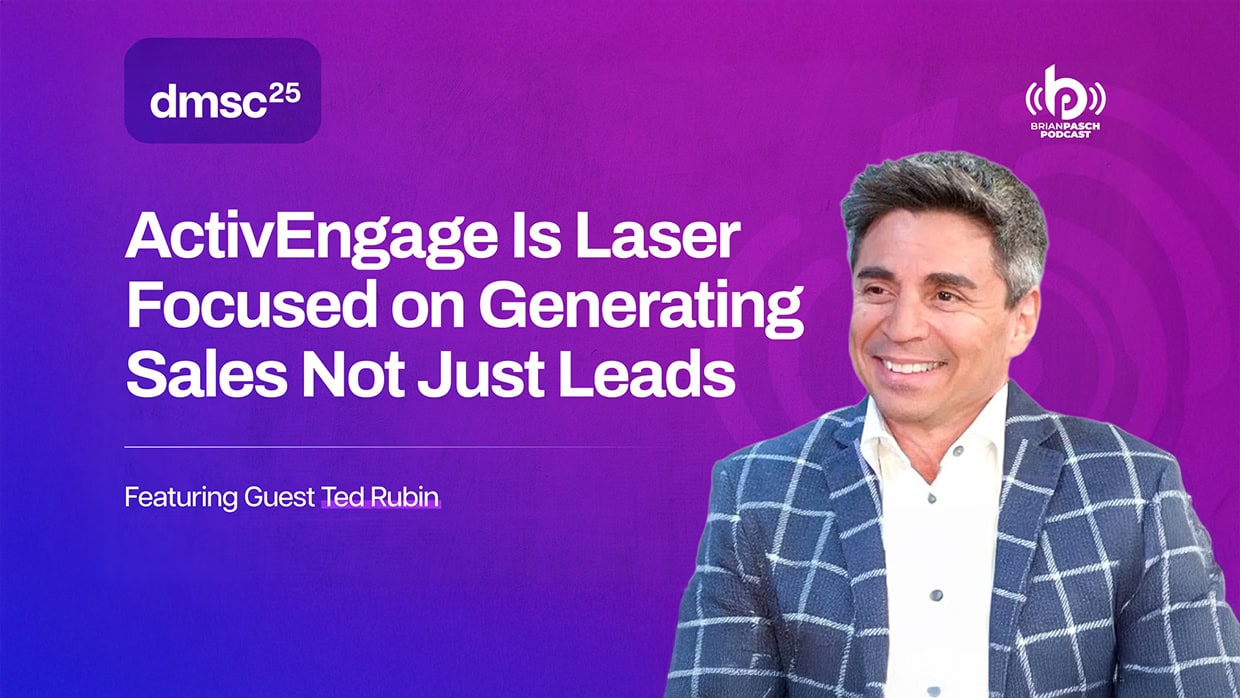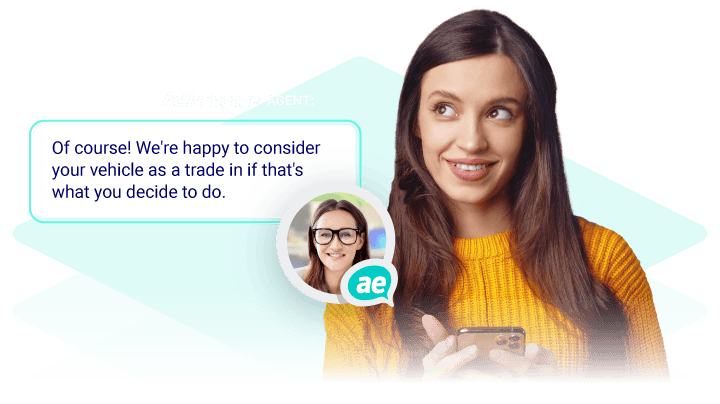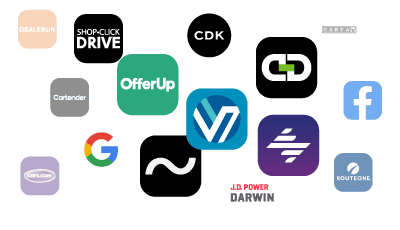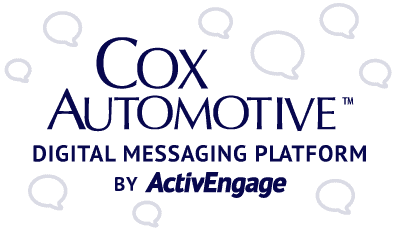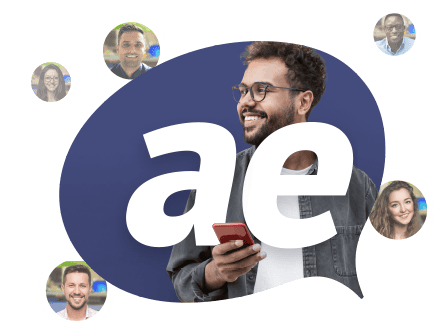Why Conversations—not Leads—Are the Real Game-Changer in Automotive Retail
In this high-impact episode, ActivEngage CEO Ted Rubin joins automotive retail strategist Brian Pasch to challenge the outdated obsession with lead generation. Instead, Rubin makes the case for a more powerful approach: real human connection through meaningful, live conversations. If your dealership is stuck in the "more leads = more sales" mindset, this is the wake-up call you've been waiting for.
Together, they dive into:
- Why most dealership websites repel shoppers by hiding behind forms
- How dealership messaging can create trust faster than any lead form ever could
- The failure of AI chat to deliver empathy—and where humans still win
- Why your staff needs to treat online conversations with the same care as showroom floor walk-ins
- How ActivEngage injects high-intent, trust-rich conversations directly into your CRM
- Innovative tools like Flip2txt and ActiveTarget that shift missed calls into live chats and static CTAs into dynamic engagement
Rubin also reveals the training and technology powering ActivEngage's standout performance. Unlike outsourced BDCs or AI that merely capture information, ActivEngage agents are trained to engage in real conversations—delivering empathy, solving problems, and moving customers deeper into the sales funnel before the dealership ever picks up the phone. That means less friction, higher appointment rates, and more customers arriving ready to make a purchase.
With 17 years of innovation behind it, ActivEngage isn't just another widget on your website—it's a strategy to modernize your entire customer engagement model. If you're ready to transform how your dealership communicates, captures, and converts, this episode will give you the blueprint.
👉 Listen now and learn how to stop chasing leads and start building buyers.
Hi, this is Brian Pasch and welcome to an exciting podcast interview. First time I have Ted Ruban, CEO of ActivEngage. We've never sat down, had a conversation. I sat down with him at nata, the conference that almost no one showed up for, but their booth was busy. Uh, I forced my way in. Get some time.
Thank you Melissa Maxey, for getting that set up. And today I wanna lean in. And really help communicate. What I see is the perfect timing for your platform, for your company vision to help dealers, uh, accelerate sales, not just leads. Ted, welcome to the show. Thanks so much for having me, Brian. I, I appreciate everything you just said.
So, uh, let's start with some basics. Uh, I'm convinced that dealers. Really hate being on the phone. Um, and the only reason why I say that is their website. Is not telling people to call or start a conversation. It's lead form, lead form, lead form, lead form, lead form. Almost like, Hey, if someone walks through the door, you're gold.
If someone comes onto my digital showroom, I really don't wanna engage with them. I'm not set up to engage with them. Let's talk about that fundamental disconnect because in the 2025 automotive website survey, I asked dealers. A fundamental question to me. I already kind of knew. I said, what do you want more of?
Lead forms, phone calls, chats, or texts. And they said, I wanted more leads. Now, when I talk to dealers, I say, well, listen, you're only talking to half of your leads. Oh, wouldn't you want a phone call? Because it's a hundred percent of the time you're communicating. And then they go, Hmm. Ted, why is that disconnect?
What's fundamentally going on in dealer's minds? Yeah, I mean, it's, it's interesting. I I, I, I think you've really hit something there in that dealers, they, they're, they're very used to. There's, you know, we, they're, we've been around for a long time, a lot of us who've been in the automotive industry, and as this evolution has happened where things have moved on online a lot more.
It's new to them and they, they're used to having people come into the store. They're used to kind of captivating them in the store, right? And they feel like, well, I can touch them and I can show them how new it is and they can smell it. And there's all these things that are going on that kind of are very attractive.
So that's my best spot is to have 'em in the store. 'cause then I won't let 'em leave basically until I kind of get my whole thing. Exactly. And you know what's really different now is that all this research, which is very tangible research is being done online. And then when they want to engage from there, that's probably one of the highest points where you can actually interact with them if you're truly trying to interact with them and you're gonna capture their attention and they're gonna be very engaged in the conversation.
They'll allow you to move them much further through the process. If you engage with them in a smart way, right, in a thoughtful way, in an empathetic way, where you're kind of truly trying to solve problems for them and not just say either come in or just kind of throw up information about the vehicles and stuff like on them.
So I think that's, that's, that's, that's my rub. Because when I see many chat experiences and I test all year long, right? Digital retailing, chat messaging, uh, anything that is on the dealer's website, I'm always testing and I feel that fundamentally dealers are bombarded with, uh, chat tools, texting tools, or remote BDC.
When I engage with them, I feel it's just another lead form. Right. Like I could ask two or three general questions and I get this feeling. They wanna get me off the chat. Yeah. Push me into a lead. Um, okay. Let's assume that that is the mindset of some companies Yeah. Generate more leads. 'cause a dealer wants more leads.
You have a different perspective. Share that perspective. What's your primary vision? When a dealer signs up with ActivEngage. Our, our goal with the customer is to really thoroughly engage with the customer and get them further through the funnel by solving problems for them and by interacting with them, like in this very human, connective way, right?
So that. We may not be friends, but we understand that we're trying to solve each other's problems and we wanna be able to get further down together. What we don't wanna do is just supply a lead to the store where they're getting it and they're basically starting from scratch, right? That's right. Now the guy at the store, the BDC or the sales person, whoever's gonna reach out, is gonna go, hi, how can I help you?
Or, hi, I know you were interested in this. Let me get started from here. That's, that's not really solving the customer's problem. 'cause they came online to start to ask questions. About the dealership and about how the sales process is gonna work there. E even when they come online to ask, you know, is the vehicle there or Do you have this color?
Or, tell me about the car. Those are not the things that they're really engaging for. They're really engaging to go, how are you gonna treat me? What's that gonna feel like? Do I believe that you're solving problems for me? You're gonna keep me in the store for four and a half hours while I sit there and try to negotiate with me.
That's the questions that are really going on. So when you engage. If, if dealers would engage those customers online the way they do in the store, then they'd get much more throughput. They'd get customers much further down the funnel. And then when we, when we send the lead, our goal is to make it so that, well, now the sales person or the BC person, when they actually go to talk to the customer after we've spoken to them, that customer's already motivated.
That customer already wants that card, that customer's. Much more likely to accept the next phone call, right, exactly. Or to accept the next email from the sales person. 'cause they feel like, okay, well I'm continuing to move forward, not I'm getting something so that I can get the initial questions that I had answered.
You know, that doesn't solve anything. So when you do that, when you kind of stop the customer from moving forward and just go, I can answer those questions or someone will answer them. Let me get your information and get you to somebody else, or you don't. Really all you do is answer the question, but you don't really engage with the customer to try to have a meaningful conversation.
Then the customer is just like, well, what am I doing here? You know, I, I did ask these things. That true, but all of that is right here on the website, right here in front of me. I, that's not really what I was trying to find out. I was trying to see how you're gonna deal with me, and if it's just gonna be superficial, I'm not interested.
And if you're not even gonna answer 'em, you're gonna send me to somebody else. Well, I don't want that either. So treat 'em like you would in the store. Treat 'em with respect. The whole thing is about, you know, kind of gaining trust and and being thoughtful. And then these customers really open up to you.
They tell you exactly why they want the car. They tell you exactly where they are, positionally what they wanna spend. They'll tell you, oh yeah, I'd like you to. Prescreen, or they won't say it in those words, but they'll say, you know, tell me if, yeah, I, I, I'd like to know a little bit better what my payment might be.
That's right. Right. And they'll let you go pretty far down the road because it's a conversation we'll get further down the road if we're using a digital retailing product, you know, during the conversation. But even without that, we'll probably get further than a lot of customers will get in digital retailing just because.
The conversation allows you to take the customer there. You know, they feel like they can ask questions, things that they don't understand as you're kind of navigating through Dr. And some other pieces as they're able to inquire, well, what does that mean? Am I gonna get my credit dinged? Or, you know, if I do this right now, will I be able to buy from somebody else?
Or any of those things. And, and, and Ted, I think you're hitting on something. I, I didn't realize it. Until you were just talking about your approach to really developing trust and relationship. And it comes down to the early versions of AI that we're seeing. Some of the AI driven, you know, chat, texting solutions, uh, I think they were focused on, and you hit it information that's already on the website.
You know, like, oh, what's the gas mile? You know, like when I see demos, they're like, oh, just ask it what its gas mileage is. Or just ask about, you know, the, does it have CarPlay and. And then what you're saying is, Hey, a lot of that stuff's already on the website. They're really looking to understand how you're gonna treat me.
What does the process look like? You know, um, am I a candidate for leasing or not? And I don't think I've seen many AI examples where they, I. Like I say, well, how am I gonna be treated? Or, you know, I have some poor credit. How's that gonna impact me? I've never seen those in a demos and maybe I'm hitting it.
It's like, hey, you know, maybe they're not, the models aren't really that well developed to build trust. Maybe they're just at this point, uh, providing information, uh, and, and maybe relevant information, but maybe that's not what the customer is looking for. How do you see AI playing out? Uh, in, in automotive retail for online shoppers?
Yeah, I mean, I think that AI is, is a valuable tool to be able to have, and we're using it all over everyday life, you know, um, and, and engaging with, with, with consumers. But, uh, the, it's a. It, it's not a conversational tool. It was not, it's not, it wasn't designed initially for that purpose, and it really hasn't evolved to that stage.
And what's interesting, like we've done some studies, there's been a lot of studies that have been done, so I don't even have to quote ours, but I. It the, it's a great tool to be able to give you a definition. So if you said, you know, what are the features on this car? Then it should be able to do that very effectively.
People also understand that whatever AI is telling you is something that someone put into it, right? Right. So that's something that it gathered from somewhere, you know, probably within your store or within the architecture of what it is. So it knows it's not a person. So like we tested it to see where we took statements that were said by live people and then put up.
A plaque that said that this was an AI solution so that customers can engage, but they believed it was ai and we said the exact same thing, but with the customer's perception, it was ai. When a customer perceives that AI is trying to be empathetic, they get pissed. That's, that's an interesting points. So for the dealers listening in, mm-hmm.
Would it be fair to say that your training, your retention, your focus is truly to be that empathetic, helpful person that will spend the time with a customer to build trust, uh, as compared to, uh, the rush to a lead? Hey, oh, that's a good question. Let me get someone to help you. Let me get your contact information because.
Dealers tell me, Brian, I can't outsource my lead handling because the people don't care. Like my people care. How would you respond to a dealer who's feeling that way when your customers are very loyal, uh, they talk about the quality of call handling. Yep. So what would you tell a dealer who feels like, Hey, um, uh, AI might be better?
Listen, I, I, I, I, there's a lot of inadequate, you know, conversations out there and people that are trying to handle it, and there's a lot of people who are trying to do it, you know, as efficiently as possible. And it's just about getting the volume in there and being able to supply a lot of leads, and there's certainly value to those leads.
That's just not, you know, I came out of the automotive industry. The reason that the company was started was really to solve this problem of giving customers. They're using this medium and they're using it more and more to do research, to have information, and now there's a communication asset there, and we want to be able to use this to treat them like they would be treated in the store so that we can allow them to matriculate themselves.
Through this process, through conversation in exactly the same way that you would do it in the store. If we're not solving that problem that way, then we're not doing what our charter or the company is to do, right? Because that's different. We're trying to get them closer to the sale, not just stop at some point and go, Hey.
You know, I don't need to do this anymore with you. Let me get you someone else and let them handle it. Right? I wanna be able to solve this problem for you. This is the perspective of everybody here. So we give them, look, I mean, our people go through walk arounds and we have dealers that are local, bring cars by, and the salespeople do walk arounds and they do 'em where then to graduate, our people have to do a walk around on the car and it's just.
That's a good example of, look, there's gotta be training. There's gotta be a way to handle things. There's a lot of conversational training to make sure that the customer stays engaged, that we are thoughtful about what is the customer trying to accomplish. Why are they doing the things that they're doing?
And let's talk about those things so that I have some insight as an assistant to you, as someone who's trying to help you, how to get through this process more efficiently for you. That goes so far in getting trust with the customer and getting them to believe that they've made the right choice by picking this dealership that now.
You know, we've gotten them much farther through. They're much more committed to this process at that moment when we release and now the store's gonna talk to them and say, well, I'm just gonna pick up from where you left off, not I'm having to start from scratch, because we really didn't gather anything from you.
I think that AI solves the problem. I mean, we use it as well to be able to gather information and to be able to give us information. But I don't like a knowledge bank. Right. To That's exactly right. Yeah, but I don't want it to convey information to the customer because. The customer doesn't see it as empathy.
The customer just sees it as like, cutesy or a little obnoxious or, you know, uh, I, I, I wanna tackle this in two pieces. One, just a, a little tactical note. Um, so when your people are responding to these leads or talking with someone on the website, are you injecting then that lead data in the CRM working in the CRM?
So they see all the notes, right? When someone's. Someone's working, uh, a live chat and you've developed empathy, you're providing information. How does all that information get into the CRM? Because you made a key point. Yeah. I'm just a tactical guy. You said we wanna bring that person closer to the sales so that when the employee of the store picks up, they're not starting from zero.
So I'm assuming some rich notes. Yes. Some coaching. Advice or whatever has to get in the CRM. How does that work practically when you're engaging people who may not be in the CRM already on the website? Yeah, so we're, you know, it's a, it's a pretty robust lead distribution, uh, or, or lead that goes into the CRMs and some of the CRMs have, you know, newer and better APIs so that we can keep expanding where the data goes, flows more specifically into certain types of field are.
Our, uh, agents, when they talk to a customer, they'll disposition the customer as well, like in our notes so they can actually say. This isn't possible to push to the CRM. So we're gonna tell you this is what the customer's thinking. This is why they're trying to do it. They're buying the car for their daughter.
They're, uh, they're looking at this car, but it's because they can't afford this car, but this is what they're trying to achieve. Okay. Okay. So there's a lot of, uh, different types of notes that will put into this system, as well as the fact that it's a very robust lead and that we're constantly working with, you know, at least the biggest CRMs that are out there.
To get, to get the API connections to get the APIs so that not only are we transferring the leads and we're transferring them securely, but we're transferring more data where it's being broken apart into the fields where the CRM can then. Take the whole lead apart. And as you wanna be able to report on that information, it's not just all sitting in the notes.
It's actually, yeah. Yeah. That's been a historical problem for sure. Yeah. Yeah. Ted, I, I'm thinking about something. I love these conversations. Uh, my brother Glen works with dealers and sales process, and you said something earlier on, I was thinking, oh, we gotta acknowledge Glenn, but he says, um, Hey. Dealers are saying, well, what should I be saying in my email communication?
And, and he just goes, what would you say if they were in the store? You know? That's right. Like, what are the questions? Right. And you said that like, treat them as if they were here. That's right. Let's, let's move to one other thought you, you mentioned about your vision to do more, to create that first, uh, great impression, building trust, empathy, and then.
Bringing them closer to a decision. Mentally, I wanna do business with this dealership. Right. I'll just share a story. I was out in Las Vegas. My wife was having a conference and we went to, uh, scar Petos in, um, the Cosmo. Yeah, the Cosmo and I, I, uh, paid for a table of 22, won an expensive place that is, and, um.
Within the first two or three minutes, three people said, wow, I don't really like this whole vibe. The wait staff, whatever happened that day in that restaurant, they, they were rushed. They had zero empathy. Right? And like, like Brian, man, you're spending a lot of money here. And I'm feeling like. They didn't even care.
You know, and I, and I bring this up because when someone puts a button on their website, get ePrice and it pops up a form, they're like, that's not what I expected. Or confirm availability. Of course, they know that the car's already there, but they pop up a form. We have no idea if this car is here and we already start to break trust, you have, uh.
Call to action products and offers that can pop up on a dealer's website that if they engage, right, if the offer is of interest, it goes right to a conversation. I've been talking about conversational commerce for a long time. Can you help me with the psychology? How does that in your mind. I know how I feel about it.
Um, how does that help build that first good impression that this dealership is different if they go to two or three dealership and it's form, form, form, and now it's like not a form, it's, Hey, I'm Brian, I'm a real person, and, uh, how can I help you about this special promotion? Yeah, I mean it's, it's the same as the difference between reading a billboard and then having someone that you can just stand there and talk to and ask a question.
I mean, it's literally that much. You're always gonna be, look, I mean, there's, there's so many studies, psychological studies that, you know, we review as well that there's this. There's this meaningfulness to just having a connection with a human person, like we're talking. And theoretically I could be AI and talking about a lot of the same things.
'cause it's, it's a quid pro quo where I'm giving you definitions and things, but there wouldn't be any connection. There'd be no rapport. There'd be no thoughtfulness about the way that we move forward. And that's, that's a huge piece of engaging. And that's, I think, why, back to the thing we were talking about in the beginning, a lot of dealers.
You know, push to get someone in the store. 'cause they're like, well, if I can see them and talk to them and they're right in front of me, then it'll be more meaningful. And there are ways to be just as meaningful in the way that you're orchestrating the conversation if you're doing it online. You just have to know how to do that.
And you have to care. You have to build that skill set, right? You have to care about wanting to try to connect with someone. In this way. So we've deployed, uh, we have active target, which is what you described with the form, but we also have something called Lead Boost, where we're basically taking that and now when the customer clicks instead of getting a form.
They'll actually connect to a live person right away. Sometimes it's a little surprising for the customer that they're talking to someone right away, so it's a little disarming for them. Right. So they're, they're almost a little excited that the fact that they're gonna be talking to someone and that they can answer questions.
We know, you know, how they've navigated the site and we know that they clicked on this particular offer or special or Right, because you're aware where they are on the dealer's website. Yeah. That, that's so, so, so important. And. Let's talk about texting. Um, so I have, boy, I'm getting old now. Ted, I'm, I used to be able to say 13-year-old son or 21-year-old.
You, me brother. I used to be able to say, okay, so you know now. Uh, you know, 28-year-old son, right? And, um, he's getting married this year. Oh, congratulations. He doesn't like to talk too much on the phone. He's more of a texter, right? So, uh, how do we deal? You have some innovative I. Um, solutions where if somebody is calling, uh, moving them to a text or back and forth, let's talk about that.
Because when I call Delta Now, or United, you know, even though I'm Diamond or one K, there's a, you know, if you would prefer to get your answers via text, you know, just press and of course. Me, I'm the generation that likes to talk to people. Right. I'm sure my son would press, you know, two to start texting because if, if somebody says I gotta wait 10 minutes, they're like, no way.
I am waiting 10 minutes. I'll just text. Right. You, your platform has that, that addresses, I guess a certain type of situation, certain type of demographics, right. Could you help the dealers know where they would insert that offering into their retail process? So the flip to text piece, which is what we're talking about, it was there, it was designed to solve a, a number of different problems.
Uh, some that, that you and I would engage with as well. Um, because it's, the initial thought was, you know, look at, look at your dealership, you know, between seven 30 and 10 o'clock in the morning or at lunchtime or in the afternoon, you know, at the end of the day that you're slammed with calls. Right. You know?
Right. Getting, uh, we were testing it with dealers without how to sip, so they had 23 lines and it would just. Ping the entire thing. It would just hit the ceiling of that every, you know, every day. And then even adding more agents. Adding more operators to the system, it would still hit it. You know, you couldn't add enough operators because there were so many people calling in, right?
To find out, can I take my car and do you have this car? Can I pick up my car? How much is this gonna cost? You know, so that was happening and they're doing it at those times, 'cause that's when they're available to call. So the, the initial part of it was to say, look, you know, we can handle things much more cost effectively for you because when someone calls in.
They're getting a busy signal if your lines are pegged, so you're not even getting through. And if they are getting through. They're getting, uh, they're waiting to get to an operator. If they get to the operator, the operator's gonna throw it up in the air and, and they're waiting for a salesperson, or they're waiting for service to pick it up where there's another operator, right?
They're in the on hold. Uh, it's like purgatory. It's like purgatory, and you just can't get out of it. So we want it to solve that problem. So we said, look, I can't just throw. Audio agents add it, it's, it's not cost effective to do it that way. Correct. So let's do this. So we made it so that as you go into the a, c, d, as you go into the automated attendant, that it'll ask you, you know, we're all busy right now, or This is what's happening.
If you want, you can text, you'll get a live person right now, but we'll do it via text. So. That was there and, and we're getting about 35% of the people who call in are actually deciding, choosing that to do that even throughout the day. So it doesn't even have to be, because it's busy, to your point about, you know, younger generations that they're choosing to engage that way.
And listen, if you just wanted to know if your car was ready, right. You know, uh, I, I, I, or make an appointment. I've serviced my car at different dealership, different ownership. I think the best was my Honda dealership in Florida. As soon as the car was done, I got a text with a payment link. Right. But that was not how the Mercedes dealer worked, you know?
And I'm wondering like, when are they gonna call? Did I miss a call? Did they forget to call me? Right. So what I'm doing, 'cause I'm running around, I'm calling them. I would definitely use the texting in that because I'm not waiting just to know if I can come and pick up my car. Right. That's the next best thing about it.
So first thing is that, so now we can get you off the phone system. So people that only wanna talk, there's more throughput to be able to get or bandwidth for them. Or leaving. Yep. Leaving. We're alleviating a lot of the stress on the operators and the people that are there. Now, it's gonna, it's gonna verify with you, this is your number.
Yes. We're gonna send you a text. You have to approve it to make sure that we're allowed to text with you. So when we do that, we're getting. Unilateral approval. So we're giving you the approval to market to them at will for whatever you want. It's not just for the purpose that they called in for. So they're documenting that and we're giving your marketing capabilities a big boost because now that's gonna go back into the CRM and you're gonna be able to market to them for anything that you want.
They approve that, right? So. Now we're talking to you and we're answering questions, and we can make appointments, we can do other things. Something else we can do from a sales standpoint is, well, now you're on text, so you're looking at your phone. So I can bring up digital retailing as I'm talking to you, I can bring up pictures of the vehicle while I'm talking to you.
I can show you other documentation or pictures of the vehicle or other things like that as it's going through service, if that's something that we wanted to be able to do with it. Got it. So now, because I've moved you to this medium in this way. That we're actually online, that that's the kind of communication that we're having for people like your son or for you in the instance that you were just talking about.
The next time that you want to reach us, you can just text us. You may not call in at all. Love that I. Now you Well, listen, I, uh, you know, it was funny I mentioned the Honda dealer. They must have changed texting platforms, Uhhuh, because I was so impressed the first time. And then, you know, I don't drive cars a lot.
I'm in the air, you know, and so it may have been a year later I'm like, ah, I better get my car serviced, right? So I texted that number, no response, and I'm like. So I called, my guy, said, oh yeah, Mr. Ham, and then he text me different number, right? They must have changed platforms, right? They must have changed, right?
So somebody didn't figure out, you know, what are all these people doing? Who saved that number? Right? You know, Ted, I mentioned that I was laughing internally when dealers said they wanted more leads over phone calls. But now when you have flipped the text, if you think about it, dealers who are listening, that phone call becomes the texting window.
And more importantly, anyone knows. That, uh, at any one time, you could have 20, you could have 50, you could even have a hundred unread emails, but that's right. You see every text message. And I think dealers need to switch their mindset Yeah. To the media channels that well consumers prefer. Number one, respect that.
Number two, the immediacy of their needs and what's the most effective channel to communicate information? To a consumer, especially transactional, right, is texting. You can do, uh, payment calc, right? You could do a credit prequal, you can send them links to anything. You can send 'em links to anything. You can send 'em contracts.
You can do anything. And, and the great part about that too is that you know when the difficulty with a call both for the dealer and for the customer, is it's at the time that you're both available only. That's right. And by doing the flip the text, they have a permanent record of anything that was sent.
Yeah. So now the consumer can talk at their time. If they start the conversation and they get interrupted or they're at work and their boss comes by and is like, Hey, what are you doing? They can stop it and restart it again whenever they want, and. Where the whole context of the conversation is held intact, and they can have that communication, continue to make their appointment, do whatever they want.
Think about, you have calls that are coming into your dealership and the, they go to sales, so they go to the operator, she puts it up in the air. All this time, this customer's on hold. They finally get through. The guy takes the phone call, has whatever conversation he has, and he may or may not document it in the CRM.
And you keep a record of the fact that there was a call. What happened? You have no idea. This is a transcript, so now we're sending this entire transcript of a phone call. Now turned into a text into your system, so you have the record of everything that was discussed. That's awesome. You know, as part of what that was, so you can start managing, okay, the people who are calling in, they're seeing this ad, or they're asking about this car, or this is the context of what they're looking for.
This is why they're contacting the dealership, and so on and so forth. People who may get transferred from one department to another. So we handle everything from sales to service. We handle appointments, we do body shop. Anything that your dealership has, we can have depth of conversation. So even if the customer mis keys it, it doesn't matter because the person who picks up, that's what I always wanted at the store when I was about running the stores, what I wanted was whoever picked up the phone, that was the person who could handle any question that you could ask.
That's what I wanted to do. So that's what we produce with Flip to text, whoever you get. If you hit service and you meant to hit sales, or if you want hit service and you meant to go to the body shop or the parts, you know what doesn't matter? Because when you get to the person, you get to, they can handle service, they can handle sales, love it.
They can make appointments, they can talk about, and you know, people jump around phone trees just for that. I mean, just how many times you've tried to call your credit card and they have all these obtuse. Uh, you know, choices, but your choice isn't, and you're like, well, let me think. Uh, I'm gonna pick open a credit card because there'll always be someone there, you know?
Right, right. You know, like people play, know the phone tree game. You know, Ted, when I think of the timeliness of your platform, uh, how many years has ActivEngage been in business? 17. Wow. So, um, um, let's, let's. Tackle a, a hard question. Um, if somebody used ActivEngage 10 years ago mm-hmm. Five years ago or today, what would you tell them today, like in 2025?
Hey, you hadn't experienced an ActivEngage 10 years ago. Here's where we've improved. Here's where our focus. What would you say? The platform has evolved because anytime you have a platform that's been around for a long time, and I have this, like Brian, you used to do digital marketing for us like 12 years ago, and uh, we, we hated it.
I'm like, well, yeah, 12 years ago was a long time, and who's your account person? I'm like, oh yeah, that, that was a mistake and I am sorry, you know, but now so many years later. What could you tell dealers, uh, about this evolution and, and the investments you've made to be their reliable, uh, partner in creating conversations?
I mean, I think that the conver, the volume of conversations is certainly a part, a big part of what that is. You know, we have tens of millions of conversations that we've had with customers and for us it's a learning opportunity and we're constantly, we've always had a piece of the system that kind of minds itself to be able to bring certain types of conversations to the forefront so that we can use them for training and teaching people how to do that.
Um, you know, I, I think a lot of the stuff that we do that is specifically directed at the conversation and training the agents, uh, that is unusual. Like we do, we teach. We teach grammar, we have, we have typing tests. We have so that you know that you're up to speed and being able to accomplish those things.
Structurally, the way conversations are held and the style in which that we answer questions is part and parcel to the way that the company looks to handle that, while still allowing the agent to kind of impart their own personality to a piece of what it is. So we want that to come through, right? We choose people that.
Um, that are specifically from the co the service industry, right? Because we want people who know how to be empathetic naturally, who are talkative, who are thoughtful, who care about talking to other people. It comes through in a job interview when you're talking to them. Of course, it has to come through on these messages and.
We have to be able to teach people how to understand how to read a message. So how many times have you sent a text to someone and went, and the person gets it and goes, what the hell? Like, why would you, and you're like, oh, that's not what I meant, right? Oh, I, I missed three or four words. Or they just read it with the different tone Right.
Then the way that you implied it. And so there's a lot of, uh, need around. Teaching people how to understand based on the tenure of the way that the rest of the conversation is going, or the initial parts of the conversation and what to say next has to do with interpreting what the disposition of the customers like.
What did they mean when they said that and how do I say something back where there's no way it's gonna be misinterpreted like in a bad. Absolutely, and, and I think that's what dealers are afraid of. Yeah. I think that is what, well, I, I think that, look, I think there's a lot of, I think that over the years that a lot of dealers have tried.
Chat and text and, and it, and, and I think for a long time it was true that the people in the stores had more information. I don't think that's true anymore, but I also think that a lot of great point, the vendors that were out there, that they just decided to become lead providers. They just decided to become, look, if I can get a name and a phone number or name and an email that I'm just gonna send it over and I'm done and I can go to the next one.
Right? Because. Dealers are getting what they asked for, but that's not really what they wanted because at the end, the ROI isn't getting more leads. It's selling more cars. That's exactly right. And that's exactly what we say about the customers. We were just talking about it. The customers come on and say, do you have that card?
That's not the question. That's not what they want. You know what they want is treat me nice. Are you gonna treat me nice? Does that seem like it's okay? 'cause that's, I'm looking at the car, so I know it's there. I exactly, I clicked on A VDP, so I know that that car has to be there. No, it, it is, it is funny.
Uh, a lot of the Getty price and check availabilities are just lead gates when dealers really understand you're not serving anyone through cryptic. Listen, the best CTAs from all testing is, you know. Value my trade, uh, what are my payments, and, uh, some type of credit preapproval, which of course, uh, you can do on the phone, uh, for any dealer, uh, using their own DR tools or generic tools if they don't have dr.
It's about answering those critical questions that build trust and bring more confidence that they're dealing with the right. Store that's going to listen and, uh, help them solve their mobility needs. You know, Ted, I'm so glad, uh, Melissa arranged our meetup at nata. It. I mean, like we've been walking side by side for years.
For a long time. We'll tell dealers need to really address, um, their retail process. They need to move towards a conversational mindset, not a lead. I'm not saying anything bad about leads, 'cause dealers might think I've lost my mind. But here's what I will tell you. Consumers know if you're gonna lead gate something, they're gonna put in a bad email address or a funky phone number.
They know how to play that game. Uh, they don't have to respond to your emails. Um, but when you. Create more conversations when you are training people to see beyond collecting PII to push into the CRM, uh, dramatic things can happen and in today's competitive environment when consumers are more unsure of what future interest rates could look like, the price.
Impact of tariffs or just the nature of, uh, so many people being upside down right in their loans. We need to provide, train people who can empathize with the consumer and help them get what they need. Ted, uh, for dealers who want to get more information on your full suite of, of retailing tools to help build better conversations that lead to sales, what's the best website for them to go to?
Uh, the best website would probably be our website, which would be www.ActivEngage.com. Great. And Ted, if somebody wanted to send you an email and talk to the boss, how would they do that? Uh, they would just go to Ted TD dot R-U-B-I-N, at ActivEngage.com. Come on. Well, Ted, thanks so much for your time and for the dealers who are listening in, um, Ted will be down at the Digital Marketing Strategies Conference.
We're gonna be talking about. How the right tech stack can really revolutionize your retail strategy. And of course, uh, Ted's team will be down there to talk about generating new revenue opportunities through rethinking how you communicate with customers. It maybe sounds very basic, but it's really not.
Um, because we have to understand what the needs are. Our today shopper, and it's not coming and filling out a lead form that's clear. So why are we so focused on that? We're gonna unpack that at DMSE and if this is the first time you're listening to one of my podcasts, there are hundreds of conversations with, uh, entrepreneurs, disruptors, and dealers who are trying to improve automotive retail.
So just search for the Brian P Podcast and enjoy those conversations. Um, Ted, thanks for your time. Howard, thanks so much for having me. It's been a great conversation. I really appreciate it. Right, well, I know the dealer's gonna get a lot out of it, so until next time, everyone who's listening in, thanks for your time and I look forward to hosting you again on another podcast sessions.
Have a great day.


